
Why Are Full-Body Swimsuits Not Allowed at the Olympics?
Introduction
Ah, the Olympics! A time when nations unite, athletes showcase their skills, and we all get a front-row seat to the latest in sports fashion—because who doesn’t want to see a bunch of swimmers in skin-tight suits? But wait, what happened to the full-body swimsuits? Remember those sleek, futuristic outfits that made a splash during the 2008 and 2012 Games? They were all the rage, promising speed and buoyancy while making athletes look like superheroes. But alas, they are now banned faster than you can say “butterfly stroke.”
The ban on full-body swimsuits stirs up curiosity like a frothy pool of bubbles. After all, it seems a tad contradictory. On one hand, we have technology racing ahead, giving athletes an edge. On the other, there’s the age-old spirit of fair competition, reminiscent of a David versus Goliath tale. So, what’s the deal? Were these suits really that game-changing, or were they just a stylish distraction?
During the 2008 Beijing Olympics, the full-body swimsuit phenomenon took off, leading to a record-breaking frenzy. Swimmers like Michael Phelps donned the infamous Speedo LZR Racer Swimsuit, which many claim turned him into an aquatic god. With nearly 200 world records shattered, it seemed like these suits were more than just a fashion statement; they were a performance enhancer. Fast forward to today, and the swimming world is left asking: how did we go from high-tech suits to a textile-only wardrobe?
As we navigate through this topic, we’ll uncover the history behind these suits, the reasons for their ban, and what swimmers will wear at the upcoming Paris 2024 Olympics. Grab your goggles and prepare for a wild ride through the intersection of technology, sportsmanship, and a splash of controversy!

Summary Section
Let’s take a moment to unpack the captivating history of full-body swimsuits and their eventual demise from Olympic competition. These suits first made waves at the 1996 Atlanta Olympics, marking the beginning of a fashion revolution in swimming. Fast forward to the 2008 Beijing Olympics, where they reached peak popularity with the introduction of the LZR Racer. This suit, developed with NASA’s help, became synonymous with speed and buoyancy, enabling swimmers to break records left and right.
However, the thrill of high-tech suits was short-lived. By 2009, the swimming authority FINA (now World Aquatics) raised concerns about “technological doping.” The LZR Racer and similar suits were made from materials like polyurethane, which provided swimmers with an unfair advantage. The results were staggering: 43 world records were set in 2009 alone, raising eyebrows and prompting an urgent response.
In 2010, FINA decided to ban full-body swimsuits, mandating that all swimwear must consist of textile-only fabric. This decision aimed to maintain fairness and integrity in the sport. For the upcoming Paris 2024 Olympics, competitors will don jammers, which extend from the waist to the knee for men, and suits that cover from the shoulders to the knees for women. To ensure optimal performance, swimmers may also benefit from high-quality Swim Goggles with Anti-Fog and UV Protection.
This shift in regulations not only underscores the importance of fairness in competition but also reflects a broader dialogue about the role of technology in sports. As we gear up for the Paris Games, it’ll be interesting to see how swimmers adapt and innovate within these new guidelines. Will the absence of full-body suits impact performance? Stay tuned as we dive deeper into the evolution of swimwear and its implications for future competitions!

The Bodysuit Revolution
The bodysuit revolution kicked off at the 1996 Atlanta Olympics. Back then, swimmers were just starting to trade in their brief-style suits for something that offered more coverage. Neck-to-knee suits made their debut, and athletes quickly embraced the change. By the 2000 Sydney Olympics, full-body suits were becoming the norm, covering nearly every inch of skin except for swimmers’ hands, feet, and heads. It felt like a fashion statement blended with a competitive edge, and let’s face it—who doesn’t love a good upgrade?
Fast forward to 2008, and we witnessed the meteoric rise of the full-body suit, especially the iconic Speedo LZR Racer. This suit was not just a piece of clothing; it was a game changer. Michael Phelps captivated audiences while donning this revolutionary suit, winning eight gold medals and breaking multiple records. The excitement was palpable, and so was the scrutiny. The 2008 Beijing Olympics became synonymous with these sleek ensembles, and soon, nearly every swimmer wanted in on the action.
However, the glory days of full-body suits were short-lived. After the 2008 Olympics, concerns emerged about fairness and the extent of technology in sports. The dramatic rise in world records raised eyebrows, leading to a pivotal moment for competitive swimming.

The Introduction of High-Tech Suits
Let’s talk tech! The introduction of high-tech suits like the Speedo LZR Racer changed everything. Designed in collaboration with NASA, this suit promised to revolutionize swimming. It featured innovative materials that enhanced buoyancy and reduced drag. Imagine gliding through water with less resistance—sounds dreamy, right?
The LZR Racer became the poster child for performance enhancement. Athletes wearing this suit shattered records at an astonishing rate. During the 2009 World Championships in Rome, 43 world records fell, many attributed to the suit’s aerodynamic design. Swimmers were not just competing; they were flying! This surge of success led to a heated debate about what constitutes an unfair advantage in sports.
As the dust settled, the swimming world faced a reckoning. The introduction of such advanced technology raised questions about the integrity of competition. Could we really call it fair if some athletes had the superpower of high-tech swimwear? Thus, the swimming community sought to restore balance and ensure that human skill remained at the forefront of the sport. To help with that balance, many swimmers are turning to Swim Caps for Long Hair to minimize drag.

Reasons for the Ban
The ban on full-body swimsuits at the Olympics doesn’t just come from a whim; it’s rooted in a quest for fairness. This journey began with the term “technological doping.” This phrase refers to the use of advanced technology in sports equipment, giving athletes an edge that can overshadow skill and hard work. In essence, it’s like using a turbocharger on a bicycle—nice, but not exactly fair!
One of the main culprits was the infamous Speedo LZR Racer. Made from 50% polyurethane, this suit significantly enhanced buoyancy and reduced drag. Imagine swimming with a floatie attached to your body! Swimmers wearing it felt like they were gliding through water, not battling it. The 2008 Beijing Olympics saw an explosion of records—43 just at the 2009 World Championships—leading to a collective gasp from the swimming community. Critics argued that these suits provided an unfair advantage, making it feel less like competition and more like a tech showcase.
In response, FINA (now known as World Aquatics) stepped in. Effective January 1, 2010, they banned the use of polyurethane and neoprene in swimsuits, mandating that all suits be made from textile-only fabric. This regulation aimed not just to level the playing field but to restore the integrity of the sport. With these changes, the focus returned to the athletes’ skills rather than their suits. And while we’re at it, a pair of Swim Training Fins can help improve your technique!
The ban on full-body swimsuits raises significant questions about fairness and competition in swimming. why are full-body swimsuits not allowed at the olympics

The Aftermath of the Ban
The aftermath of the ban on full-body swimsuits reshaped competitive swimming. Suddenly, world records set with high-tech suits took on a different context—like a magician revealing his tricks. Many records achieved during the LZR era now carry asterisk-like notations, reminding us of the technological advantage that once existed.
Athletes reacted in varied ways. Some welcomed the change, eager to compete on a level playing field. Others lamented the loss of a tool they felt improved their performance. The swimming community buzzed with discussions about the future of swimwear. Would this lead to a decline in record-breaking performances? Or would it emphasize raw talent and training?
As we approach the Paris 2024 Olympics, the swimming landscape looks different. Swimmers will don jammers and knee-length suits, focusing on technique and training, rather than relying on technology. The debate over technology versus talent continues, but one thing is clear: the integrity of the sport remains paramount. And to keep those muscles in shape, consider incorporating Resistance Bands for Swim Training into your workout routine!

Overview of Swimwear Guidelines
When it comes to Olympic swimwear, regulations are as tight as the suits themselves. For men, the current standard requires “jammers,” which are snug-fitting swimsuits that extend from the waist to just above the knees. It’s like wearing a stylish pair of shorts, but with way more pressure to perform!
Women, on the other hand, sport swimsuits covering from the shoulders down to the knees. This design is both functional and fashionable, allowing for freedom of movement while maintaining a competitive edge. Gone are the days of full-body suits that covered every inch of skin—thankfully, the swimsuit police are on high alert!
Now, let’s talk approvals. All swimwear must pass the scrutiny of World Aquatics, the governing body overseeing these regulations. Each suit needs to be submitted for approval, ensuring it meets the textile-only fabric requirement. No sneaky polyurethane or neoprene allowed! This process might sound like the Olympics for fabric, but it’s crucial for fair play. While you’re at it, don’t forget to keep your swim gear organized with a Swimwear Fabric Care Wash to keep everything in top shape!

Implications for the 2024 Paris Olympics
As we gear up for the Paris 2024 Olympics, swimmers can expect a fresh wave of creativity within the new regulations. Designers are likely to embrace innovative textile technologies that enhance performance while adhering to the guidelines. Think of it as a fashion revolution—minus the full-body suits.
The buzz around swimwear design is palpable. Expect to see a mix of bold colors and unique patterns that stand out in the pool. Additionally, there’s potential for technological advancements within these limits. Swimmers might benefit from materials that improve comfort and reduce drag without crossing the line into “technological doping.” And to keep those tunes pumping, a Portable Waterproof Speaker might just be the perfect companion for those pre-race hype sessions!
In summary, the Paris 2024 Olympics will showcase not just athletic prowess but also the evolution of swimwear within strict rules. It’s a balancing act that combines style and function, ensuring every swimmer can shine in the spotlight while keeping the competition fair and square.

Conclusion
In the ever-evolving world of sports, the balance between innovation and tradition is crucial. Full-body swimsuits, once the pinnacle of swimming technology, faced the axe due to concerns over fairness. The technological arms race in swimwear raised valid questions about the spirit of competition. While these suits offered undeniable performance boosts, they blurred the lines of equitable play, reminiscent of a superhero donning an unfair advantage.
As we look towards Paris 2024, one thing is clear: the evolution of swimming attire isn’t merely about aesthetics. It reflects a broader dialogue about the essence of sport. Swimmers will continue to innovate within the guidelines set by World Aquatics, embracing creativity while adhering to the spirit of fair play. The future of swimwear will blend cutting-edge designs with the timeless principles of sportsmanship, reminding us that, at the end of the day, it’s all about the thrill of competition and the dedication of the athletes. For those looking to enhance their training, consider investing in an Athletic Swim Watch with Lap Tracking to monitor your progress!

FAQs
What specific materials are banned in Olympic swimsuits?
Polyurethane and neoprene are off-limits. These materials were thought to provide an unfair performance edge.
Can swimmers wear full-body swimsuits in any other competitions?
While full-body suits are banned in the Olympics, some local or less regulated competitions may still allow them. Always check the specific rules!
How has the ban affected the performance of Olympic swimmers?
The ban has shifted focus back to technique and training. While some records have become harder to break, it emphasizes the human element of swimming.
What are the current trends in swimwear design for the Olympics?
Expect innovative designs using only textile materials that enhance comfort and reduce drag while maintaining compliance with regulations. Bold colors and creative patterns are on the horizon!
Please let us know what you think about our content by leaving a comment down below!
Thank you for reading till here 🙂
All images from Pexels




